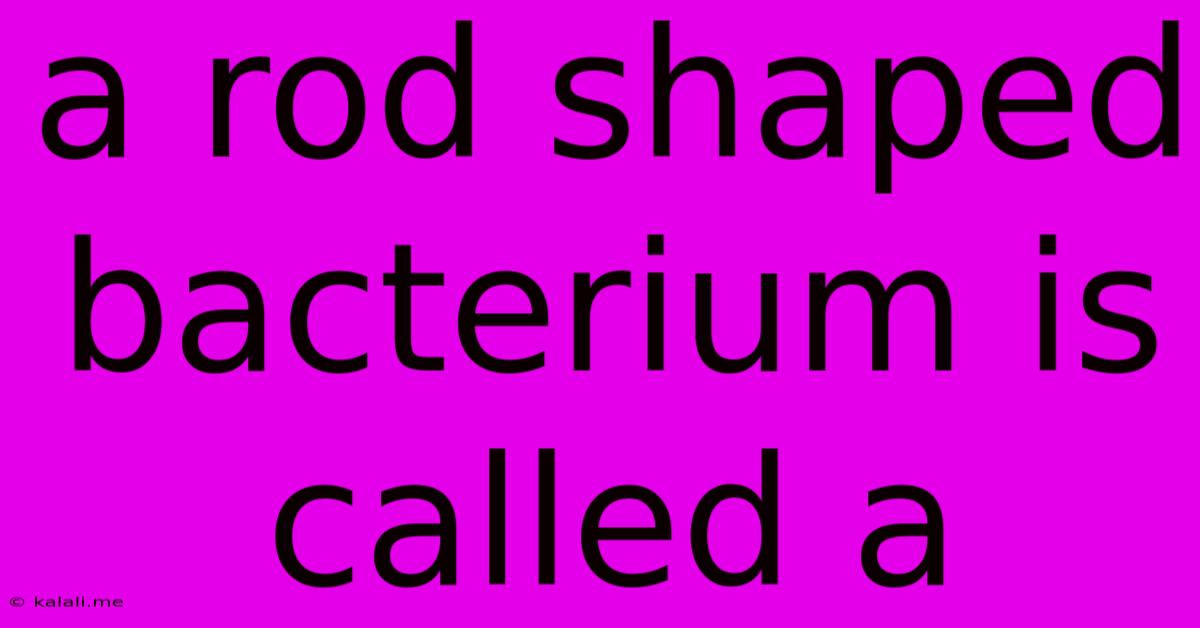A Rod Shaped Bacterium Is Called A
Kalali
Jun 13, 2025 · 3 min read

Table of Contents
A Rod-Shaped Bacterium is Called a Bacillus: Understanding Bacterial Morphology
A rod-shaped bacterium is called a bacillus (plural: bacilli). This is a fundamental aspect of bacterial morphology, the study of the shape and structure of bacteria. Understanding bacterial shape is crucial in microbiology for identification, classification, and understanding their pathogenesis (ability to cause disease). This article will delve deeper into bacilli, exploring their characteristics, variations, and significance.
What exactly defines a bacillus?
The term "bacillus" refers specifically to the shape of the bacterium. It's important to distinguish between the term "bacillus" as a shape descriptor and Bacillus as a genus name. Many genera contain rod-shaped bacteria, but only those within the Bacillus genus are considered members of that specific taxonomic group. A rod-shaped bacterium can be described as a bacillus regardless of its genus classification. Think of it like this: all squares are rectangles, but not all rectangles are squares. Similarly, all Bacillus bacteria are bacilli, but not all bacilli are Bacillus.
Variations in Bacillus Shape:
While generally rod-shaped, bacilli exhibit some variation in their morphology:
- Coccobacilli: These are short, plump bacilli that almost appear coccus (spherical) shaped. They represent a transition between cocci and bacilli.
- Diplobacilli: These are pairs of bacilli attached end-to-end.
- Streptobacilli: These are chains of bacilli linked end-to-end.
- Palisades: Bacilli arranged side-by-side, resembling a picket fence. This arrangement often results from the plane of cell division.
These variations in arrangement are often species-specific and helpful in identification. Microscopic examination allows microbiologists to observe these distinct morphologies and use them as a key in diagnostic procedures.
Significance of Bacillus Shape:
The shape of a bacterium is often linked to its function and survival strategy. The rod shape, for example, can:
- Enhance motility: The elongated shape can be advantageous for movement through viscous environments.
- Increase surface area: This can improve nutrient uptake and waste excretion.
- Provide structural strength: The rod shape offers some resistance to environmental stressors.
However, the correlation between shape and function isn't always straightforward. Many factors, including genetic makeup and environmental conditions, play a role in determining a bacterium's final morphology.
Beyond the Shape: Other Important Characteristics:
While the shape is an important initial identifier, other characteristics are necessary for complete bacterial identification. These include:
- Gram staining: Whether the bacterium is Gram-positive or Gram-negative provides crucial information about its cell wall structure.
- Oxygen requirements: Is it an aerobe, anaerobe, or facultative anaerobe?
- Metabolic capabilities: What nutrients does it utilize? What byproducts does it produce?
- Genetic analysis: Modern techniques like 16S rRNA sequencing allow for precise identification at the species level.
Conclusion:
In conclusion, while the term "bacillus" simply describes the rod shape of a bacterium, understanding this morphology is a vital first step in the process of bacterial identification and characterization. This information, coupled with additional analysis of other characteristics, allows microbiologists to understand the behavior, ecology, and potential pathogenicity of these microorganisms. Further research into bacterial morphology continues to reveal the intricate relationship between bacterial shape and its various biological functions.
Latest Posts
Latest Posts
-
How Many Moles Of Aluminium Sulphate
Jun 14, 2025
-
Stress Strain Graph For Cast Iron
Jun 14, 2025
-
Difference Between American Culture And Indian Culture
Jun 14, 2025
-
A Sand Scorpion Can Detect The Motion
Jun 14, 2025
-
Lateral Area Of A Rectangular Pyramid
Jun 14, 2025
Related Post
Thank you for visiting our website which covers about A Rod Shaped Bacterium Is Called A . We hope the information provided has been useful to you. Feel free to contact us if you have any questions or need further assistance. See you next time and don't miss to bookmark.